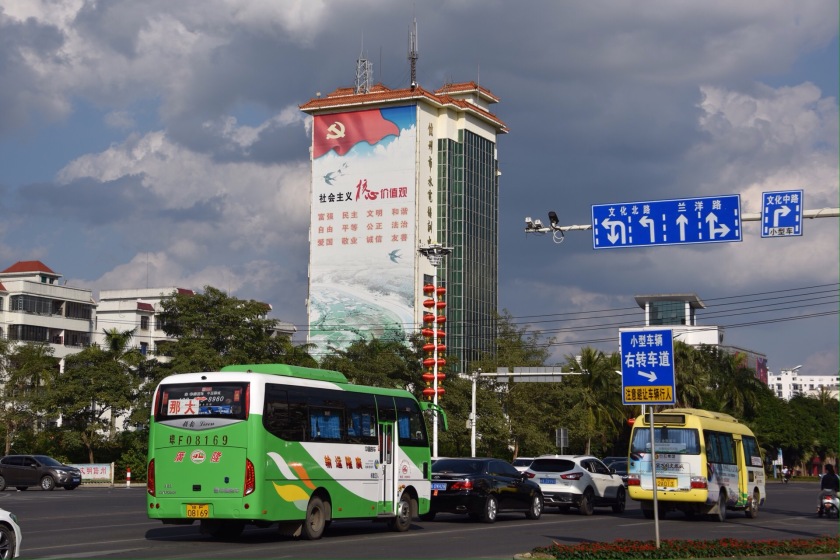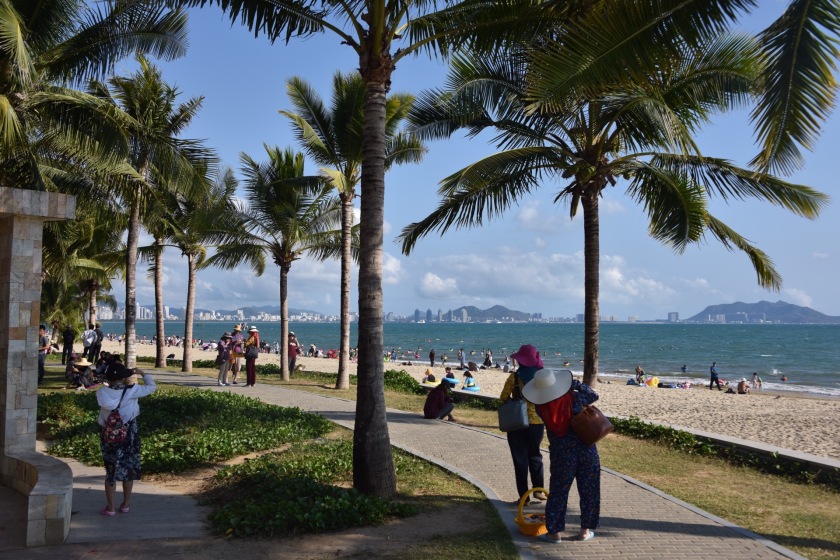From Nadao we take a bus to Sanya, because the other west coast has not much to offer, and another day with less distance, after the long journey and the not yet fully digested first day with almost one hundred kilometers distance, does quite well ,
We are early at the bus terminal to buy the tickets, because there will only be two connections for today. There is already a lot of hustle and bustle in front of the ticket vending machines and there is already a long queue in front of the only counter that is open, so it takes about 20 minutes to get tickets for the 11 o’clock bus. Whether we can take the bikes, we don’t get a confirmation.
Then once breakfast, the hotel had offered to cook rice porridge, which quickly makes you very full. Half past 10 we are back at the bus terminal. There is hectic operation at the driveway, people are brought by taxis or picked up, local buses stop in the secondary carriageway, where mopeds circulate in both directions and also a fruit merchant offers his goods. So we have to be careful when entering the small forecourt.

For the ticket purchase I already had to present my passport, whose number with my name was then printed in the ticket, and now when entering the waiting hall, the ticket is compared with the passport by a police officer, the luggage is illuminated, but the bike is allowed as it is through the metal detector. Safety is apparently taken seriously in public transport, as I already had noticed the day before yesterday at the station of Lingao, where we first wanted to ask for the transport of the bikes. But bicycles are not allowed in high-speed trains, which are used exclusively in Hainan. We also had to park them far away from the station building, the local police had not even let us on the forecourt with them.
The door to the outside, where the bus is waiting, will open 10 minutes before the scheduled departure. It’s a small bus with maybe 35 seats, but we’re lucky with the wheels as few of the passengers stow their luggage in the cargo hold. So handlebars cross over and with some skill we get the two bikes pushed into the hold of the bus. They then each cost 40 Yuan extra, which will be collected directly by the bus attendant, additionally to 78 Yuan for the simple passenger one-way ticket.

Nadao is not a big city, but nevertheless the bus hangs in the three-lane traffic jam and comes slowly out of the city. The road is uneven and the rider has a rather rough way of stopping the car every few meters. Quickly some people get sick and soon a sour smell moves through the interior. That can still be cheerful, where the ride is just beginning, I think. For a while, I wonder if I even rummage a small plastic bag out of my bag – just in case. But the bad feeling passes again. The affected people later throw their small black plastic bags forward in the corridor of the bus, which stops sometimes at the edge of the road, where a companion of the driver then transported the garbage outside.
In general, the bus stops several times after we are long out of town right on the freeway. Under a road bridge at the edge of the road, or at an exit, where people are still boarding. Each time, the companion brings out a mini-folding chair from the top shelf, on which the passengers can sit down in the small open space in the front bus area. The security is obviously relatively far interpretable.

The journey ends after about four hours on the edge of Sanya, at the bus terminal West. From there it is still about 15 km to the center, for which we take our time in the afternoon sun. The city on the southern tip of Hainan extends over a promontory in a southerly direction and from a distance you can see the long skyline while you just reached the bay of Sanya. Sandy beach and a beach park stretch over many kilometers along the coastline and in about 50 to 200 m distance runs a busy road, where soon the first hotel buildings line up on the side facing away from the beach. Soon one hotel or resort follows the next, partly set back from the road and often luxuriously designed. For a while I feel reminded of Kalakaua Avenue in Waikiki. In many places, there are small parking lots on the edge of the beach park, all crowded, and at the driveways caution is required, as the cars partially block the road, because apparently they do not really know where to go. Uniformed guards make sure that at least not on the street is parked.
Sanya is located approximately at the southernmost point of the island and from here we drive along the east coast back to Haikou in the following five days. Not always directly on the coastline, sometimes even quite inland, if the route that we follow takes its way with as few inclines through the partly mountainous landscape.
Apparently, many people want to head southeast out of the city, and after crossing the two bridges over the Sanya River, we’ll be swimming with heavy traffic past a naval base along the G224, around a 400-meter-high mountain, and away from the more densely populated area.
Soon there is traffic jam on this arterial road, which forms a branch in the direction of a popular bay with adjacent nature reserve. Behind the branch, which doesn’t interest us, we are almost alone on the wide road, then.
In the Bay of Haitang we finally get off this freeway, which, nicely nestled between two wooded hills though – but it’s nicer to follow narrow roads with less traffic. Also along this bay the government obviously is investing into the future and diligently concreted. Roads and paths are already there, green strips and rows of palm trees, which are watered consuming, but the actual construction areas are still not really developed – over many kilometers. Only in the northern area can be seen more high-rise lines near the coast, in addition to an imposing hotel tower in hinted sail form.
Inland, villages lie in the heat of the early afternoon. It has about 28° in the shade and we are looking for a small restaurant in the center of one of the villages. The street leading into it seems to have been newly created, posters tell about it (at least I get it translated) that with the demolition of the old substance the place has become much more modern. Opposite a store / restaurant row, in the shade of which we order rice noodle soup with vegetables and peanuts, there are modern, two-storey terraced houses, freshly whitewashed and probably only completed recently.
For a few kilometers back to the highway, as rivers and the Hainan spanning highway must be crossed twice, then it goes quickly back to the rural, coastal Hainan. I had already noticed the chili cultivation before, at the village of Dapo some people in the field are busy with the harvest. The plants are apparently very different, depending on when the plants have been set, because in other chili fields I had seen the low bushes also blooming. These here carry long, narrow fruits, which soon pile up in large sacks on the roadside.
In Xincun it is time to search for accommodation, which doesn’t work at the first guesthouses we ask for and which are a bit off the main road. Either fully booked, or simply closed. Although Xincun is a larger nest, it is nicely off the peninsula of Monkey Island, to which a cable car passes, and is therefore popular with day visitors. So while we arrive, we notice a bit of life and noise in the central street of the place. Most traders and street kitchens, however, dismantle or pack in as early as dawn.